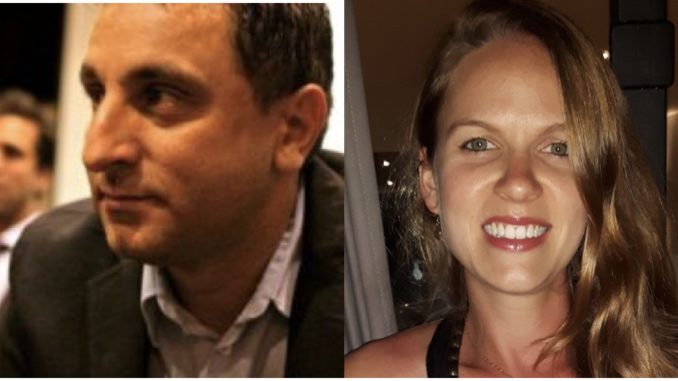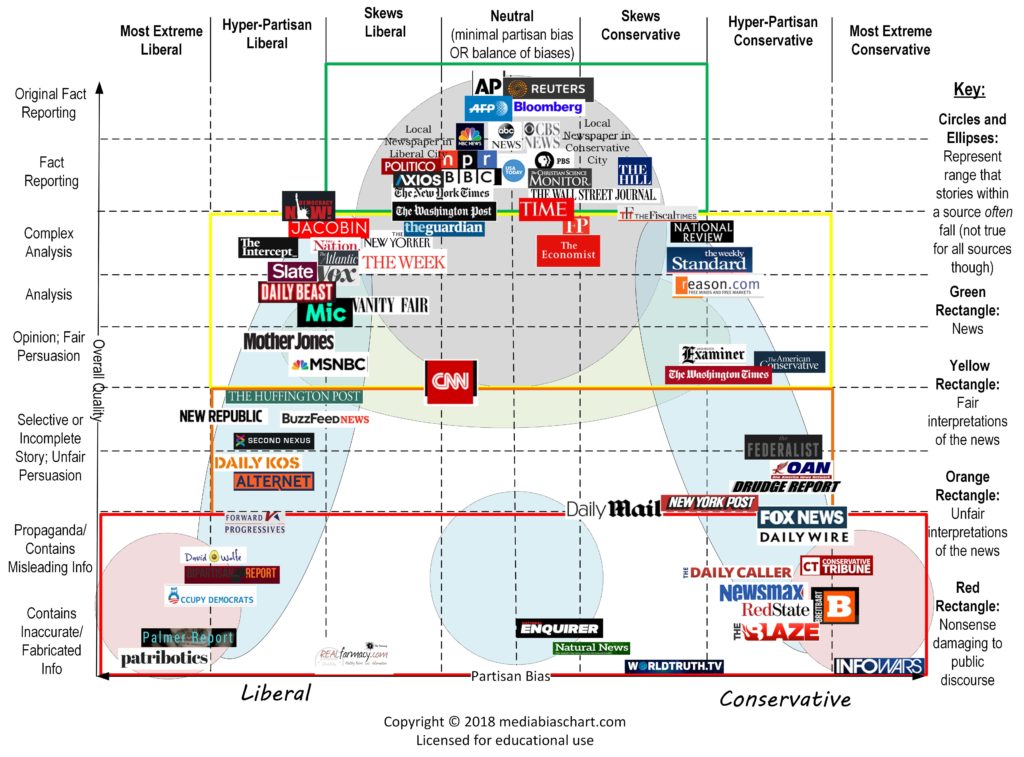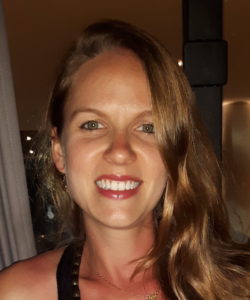
By Alec Couros and Katia Hildebrandt
Those of us who grew up in a pre-Internet world probably remember passing through grocery store checkout aisles lined with copies of the National Enquirer and other tabloids, with outrageous headlines proclaiming “BAT CHILD FOUND IN CAVE,” “HILLARY CLINTON ADOPTS ALIEN BABY,” or “DOLPHIN GROWS HUMAN ARMS.” Even as children, it was easy to distinguish those fake stories from real news, not just because of the sensational claims but also because of the telltale fonts and the obviously manipulated or fabricated images. Looking back, the division between fake news and authentic journalism seemed quite clear.
In today’s world, however, the line between real and fake seems increasingly blurred and uncertain. False stories are no longer relegated to tabloid publications but instead have infiltrated more mainstream media sources and social networking services. While the ludicrous claims of tabloid fare were meant mostly to entertain, today’s fake news is a more insidious specimen; in many cases, there is a sinister intent to its creation and dissemination. Indeed, the dictionary.com definition of fake news reads: “false news stories, often of a sensational nature, created to be widely shared online for the purpose of generating ad revenue via web traffic or discrediting a public figure, political movement, company, etc” [emphasis added].
For many of us, the rise of fake news has become inextricably linked to the 2016 U.S. presidential election. Data now shows that in the lead-up to election day, the top twenty fake news stories outperformed the top twenty mainstream (legitimate) new stories on Facebook, with the former netting about 1.4 million more engagements (shares, reactions, and comments) than the latter. And the creation and spread of the plethora of fake news stories was undeniably intentional; for example, reports emerged after the election about a small town in Macedonia in which a number of teens specialized in creating false, pro-Trump news articles for the purpose of generating ad revenue. Interestingly, the teens were not necessarily Trump supporters but rather had discovered that disseminating these articles was highly lucrative (earning tens of thousands of dollars in a country where the average monthly salary is $371 USD). While the Internet has often been touted as a democratizing force where all voices can be heard, clearly there are both benefits and drawbacks to a world when anyone can publish anything.
Fake News in a Digital World
Why is fake news so much harder to deal with today? One of the major changes is the prevalence of easily accessible digital tools that allow anyone to create realistic but false messages, videos, and voice recordings. For instance, in the last year, a human image synthesis technique called DeepFakes has gained infamy online; the technique uses Deep Learning (artificial intelligence) algorithms to find patterns in facial photographs in order to add someone’s face to an unrelated video. While the technique is fairly new, there has been great fear about the potential misuse of the technology for the use of fake political messages or revenge porn.
As well, there are new tools on the horizon that threaten to further complicate our ability to judge what is real and what is fake. For instance, Voco, an experimental tool from Adobe, has been touted as “Photoshop for voice;” if released, the tool would enable the use of existing voice samples to copy anyone’s voiceprint in order to create new messages. Additionally, in recent weeks Google demonstrated the Assistant feature at a conference, illustrated how the soon-to-be-introduced technology would allow personal bots to communicate fluently with others over voice using artificial intelligence. It is not difficult to envision myriad ways in which these new technologies could be misused in order to trick or mislead unsuspecting audiences.
Thus, while fake news is certainly not new, and there have long been mechanisms for creating deceptive and misleading artefacts, we are now entering a brave new world where the truth is more and more difficult to uncover. Thanks to sophisticated tools, the deeply ingrained maxim that “seeing is believing” has become a liability; instead, we have entered an era in which fake news has truly become an information validation problem that will require new strategies for discerning what is real. Moreover, this challenge is only exacerbated by the sheer volume of information (both true and false) being circulated. Indeed, Garry Kasparov, the chess Grandmaster and political activist, notes, “The point of modern propaganda isn’t only to misinform or push an agenda. It is to exhaust your critical thinking, to annihilate truth.”
Why Don’t Our Traditional Strategies Work Anymore?
For many years, we have relied on checklists in order to determine the quality of online information. Most of these checklists take the form of an acronym; for instance, three commonly used tools for evaluating information are RADCAP, CRAAP, and CARS. Unfortunately, these tools are no longer adequate for navigating the current media landscape. On a basic level, using a checklist to deal with the sheer abundance of information available is simply not practical; as Mike Caulfield notes, “In reality, most literacies are heavily domain-dependent, and based not on skills.” In other words, it’s no longer enough to know how to check the date on an article or search for the name of the author; instead, in a world where every piece of information is suspect and potentially falsified, we need to be able to apply web-specific knowledge, such as understanding the implicit biases of various news sites or knowing which fact-checking sites are trustworthy.
Simply put, the checklist models are no match for the sophistication of today’s fake news – they were designed with a simpler media landscape in mind. If we take the idea of authorship (also referred to as authority or credibility), for example, we can easily see where these models break down. The checklists would suggest that we can evaluate a piece of media by looking at its origin. However, the authorship of an artefact can easily be falsified; on social networking sites, for instance, we have seen how both bots and paid “trolls” can masquerade as “reliable” sources in order to spread false information and then amplify it through (bot- and troll-generated) shares and retweets. (For a deeper analysis of the shortcomings of checklist models, see Caulfield’s site.) As well, in our current political era, legitimate authorship is no guarantee; for example, a checklist model would likely give a U.S. president a pass on credibility, but President Trump is known to have spread falsehood both online and off (so much so that Politifact has compiled a lengthy list of the false statements he has uttered). And in the Canadian context, on the other side of the political spectrum, sites like TrudeauMeter take on a similar, non-partisan function in assessing the Prime Minister’s performance related to election promises. Complications around the very concept of authority, and the notion that authority equates to credibility, make it impossible to use un-nuanced checklists in order to assess the truth.
New Strategies and Techniques for Dealing with Fake News
Given the shortcomings of existing tools for evaluating information, we’ve compiled a few suggestions for dealing with today’s fake news.
1. Develop and employ investigative techniques: Rather than relying on a checklist, it’s important that we develop the capacity to employ more sophisticated techniques and strategies when assessing information. These techniques include:
- Knowing about and using available web tools – There are multiple tools and sites that are available to help deal with false information, and an important part of tackling the issue of fake news is to be aware of these resources. For instance, it’s helpful to know about reliable fact checking sites such as Snopes, Politifact, and FactCheck.org. These sites assess news stories and claims that are circulating and then rate each one for accuracy. Another helpful tool is Google’s reverse image search, which allows you to search for a picture to determine where the image originally appeared and whether it has been altered. As well, VerificationHandbook.com is an excellent source of information that details how to verify particular types of media including images and video.
- Reading like a fact checker: It’s also important to understand how professional fact checkers read and evaluate online sources, in order to emulate their strategies. A 2017 study observed 45 individuals (10 PhD historians, 10 professional fact checkers, and 25 Stanford undergraduate students) as they evaluated live websites. The researchers found that both the historians and the students were easily influenced by false elements of websites, including logos and domain names (both of which are easily manipulated). Importantly, these individuals employed the practice of reading “vertically,” that is, staying on the same site in order to assess it. On the other hand, the professional fact checkers read “laterally,” meaning that instead of evaluating the site itself, they searched outside sources for corroboration. This is a key technique for evaluating sources, especially given the many strategies and tools available for generating a scaffolding of falsified supports around any given fake site or article.
- Understanding and identifying biases: Finally, it’s important to learn how to read critically in order to assess the biases of particular sources. This is sometimes a matter of knowing which resources are available to help determine biases; for instance, this chart does an excellent job of laying out the media landscape according to political leaning and general reliability of reporting.

2. Use rich examples: When it comes to helping others understand the complexities of fake news and how to deal with this important issues, it can be very helpful to use rich, real-life examples of falsified stories or images. Of course, there are many pre-fabricated examples of fake artefacts, and over the years, we’ve seen teachers making great use of “fake sites” designed to help students develop information literacies/skills, including DHMO.org, Save the Endangered Pacific Northwest Tree Octopus, Feline reactions to bearded men, and BuyDehydratedWater. But while these are still great resources that can be used with some success, given the abundance of fake news and internet scams that inundate our digital society, there are plenty of opportunities to use fresh and authentic examples in class.

For instance, take this image of Hillary Clinton on the campaign trail, purportedly standing next to a woman wearing an “I’m with stupid” t-shirt that points to Clinton. The image circulated on Facebook in July of 2015, with the criticism that Clinton was “too into herself to notice a t-shirt.” As an activity, we might try to use the techniques listed above to determine whether the photo is legitimate. In this case, we could use the aforementioned Google reverse image search to find the original photo, which would quickly tell us that earlier versions of the photo included a plain white t-shirt without writing on it. A reverse image search would also lead us to the Snopes page dedicated to the image, which provides additional details about the spread of the hoax. In today’s fake news world, similar examples are readily available for use as authentic case studies.
3. Nurture a Critical Disposition: Ernest Hemingway once remarked that “the most essential gift for a good writer is a built-in, shockproof, s*** detector;” in today’s fake news world, the ability to detect lies and nonsense is essential not just for writers but for readers as well. For better or for worse, however, we humans often seem inclined to believe what we see, hear, and read. As such, a third key strategy for dealing with fake news is the development of a critical disposition. Essentially, one of the key challenges of the current age is the need to retrain ourselves to look at the world with an attitude that demands that we question everything, not so that we are paralyzed by uncertainty but so that we are liberated, freed from a world of mistruths and able to assess “reality” in order to create a more accurate picture of the world than the one that is being presented.
 Alec Couros is a Professor of educational technology and media at the Faculty of Education, University of Regina. He has given hundreds of workshops and presentations, nationally and internationally, on topics such as openness in education, networked learning, social media in education, digital citizenship, and critical media literacy. His graduate and undergraduate courses help current and future educators understand how to use and take advantage of the educational potential offered by the tools of connectivity.
Alec Couros is a Professor of educational technology and media at the Faculty of Education, University of Regina. He has given hundreds of workshops and presentations, nationally and internationally, on topics such as openness in education, networked learning, social media in education, digital citizenship, and critical media literacy. His graduate and undergraduate courses help current and future educators understand how to use and take advantage of the educational potential offered by the tools of connectivity.

Katia Hildebrandt is a Ph.D. candidate and instructor in the Faculty of Education at the University of Regina. Her doctoral research is in the area of social media and anti-oppressive education. A former middle years and high school educator, Katia now teaches undergraduate and graduate students in the areas of curriculum, pedagogy, and educational technology.